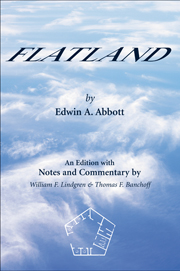Book contents
- Frontmatter
- Contents
- Acknowledgments
- Introduction
- Flatland with Notes and Commentary
- Part I This World
- 1 Of the Nature of Flatland
- 2 Of the Climate and Houses in Flatland
- 3 Concerning the Inhabitants of Flatland
- 4 Concerning the Women
- 5 Of our Methods of Recognizing one another
- 6 Of Recognition by Sight
- 7 Concerning Irregular Figures
- 8 Of the Ancient Practice of Painting
- 9 Of the Universal Colour Bill
- 10 Of the Suppression of the Chromatic Sedition
- 11 Concerning our Priests
- 12 Of the Doctrine of our Priests
- Part II Other Worlds
- Epilogue by the Editor
- Continued Notes
- Appendix A Critical Reaction to Flatland
- Appendix B The Life and Work of Edwin Abbott Abbott
- Recommended Reading
- References
- Index of Defined Words
- Index
10 - Of the Suppression of the Chromatic Sedition
Published online by Cambridge University Press: 05 August 2013
- Frontmatter
- Contents
- Acknowledgments
- Introduction
- Flatland with Notes and Commentary
- Part I This World
- 1 Of the Nature of Flatland
- 2 Of the Climate and Houses in Flatland
- 3 Concerning the Inhabitants of Flatland
- 4 Concerning the Women
- 5 Of our Methods of Recognizing one another
- 6 Of Recognition by Sight
- 7 Concerning Irregular Figures
- 8 Of the Ancient Practice of Painting
- 9 Of the Universal Colour Bill
- 10 Of the Suppression of the Chromatic Sedition
- 11 Concerning our Priests
- 12 Of the Doctrine of our Priests
- Part II Other Worlds
- Epilogue by the Editor
- Continued Notes
- Appendix A Critical Reaction to Flatland
- Appendix B The Life and Work of Edwin Abbott Abbott
- Recommended Reading
- References
- Index of Defined Words
- Index
Summary
The agitation for the Universal Colour Bill continued for three years; and up to the last moment of that period it seemed as though Anarchy were destined to triumph.
A whole army of Polygons, who turned out to fight as private soldiers, was utterly annihilated by a superior force of Isosceles Triangles – the Squares and Pentagons meanwhile remaining neutral. Worse than all, some of the ablest Circles fell a prey to conjugal fury. Infuriated by political animosity, the wives in many a noble household wearied their lords with prayers to give up their opposition to the Colour Bill; and some, finding their entreaties fruitless, fell on and slaughtered their innocent children and husbands, perishing themselves in the act of carnage. It is recorded that during that triennial agitation no less than twenty-three Circles perished in domestic discord.
Great indeed was the peril. It seemed as though the Priests had no choice between submission and extermination; when suddenly the course of events was completely changed by one of those picturesque incidents which Statesmen ought never to neglect, often to anticipate, and sometimes perhaps to originate, because of the absurdly disproportionate power with which they appeal to the sympathies of the populace.
It happened that an Isosceles of a low type, with a brain little if at all above four degrees – accidentally dabbling in the colours of some Tradesman whose shop he had plundered – painted himself, or caused himself to be painted (for the story varies) with the twelve colours of a Dodecagon.
- Type
- Chapter
- Information
- FlatlandAn Edition with Notes and Commentary, pp. 88 - 96Publisher: Cambridge University PressPrint publication year: 2009



